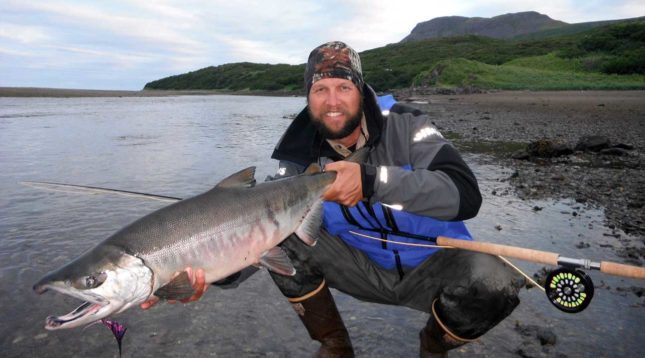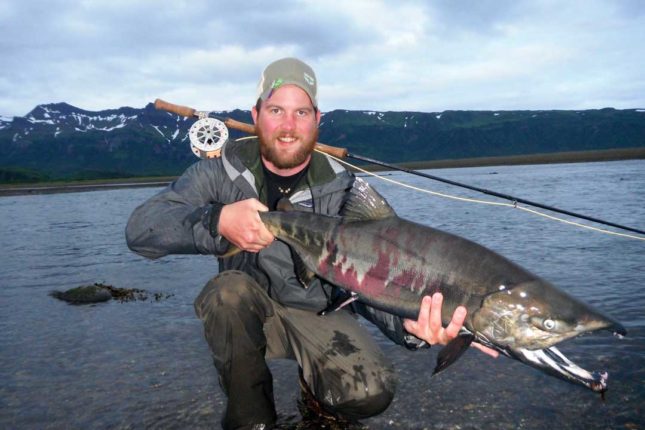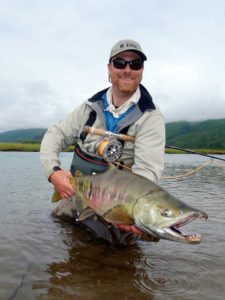Epic Blog
Machete’s Guide Gear Talk – Spey Fishing, part 2
10.12.20

Both spey and switch rods are extremely effective at throwing heavy flies to salmon at SAFARI camp, but the longer rods are not always a first choice.
Hey folks, welcome back to spey rod talk. In part 1 we skimmed over some brief history regarding these unique fly rods and touched on some of the main differences between casting a single-handed rod and casting a spey rod. During this segment let’s dive into some considerations for spey rod applications at our SAFARI camp.
Pros and cons
First we should specify the advantages and disadvantages of utilizing a two-handed rod.
One of the most immediate advantages is gaining effortless casting distance. This feature has much to do with the kinds of lines used on a two-handed rod. As was mentioned previously there are many different types of lines available for use on two-handed rods, but what nearly all of them share in common is they are shooting head configurations. Essentially these line systems break down into having two components: the head and the running line.
This configuration allows for a heavier head to be launched into the air with the thin diameter of the running line aiding in achieving maximum distance. Imagine a heavy harpoon tethered to a coil of rope being fired from the bow of a ship. This is analogous to the relationship the head has with the running line when used on a two-handed rod. But does this make for an ideal rod and line system for the specific water conditions at our SAFARI camp?
Niche scenario
The answer is not black and white, but in general I would say that it skews more towards no than yes. Here’s why; one of the most important ingredients for using any two-handed rod is current. This is not only essential for being able to present the fly correctly, but also for utilizing the line in the way that it was intended. Two-handed rods are primarily meant to swing a fly in a downstream presentation. An ideal setting for this would be a larger to medium sized river where casting distance is aided by the advantages of a spey rod.
The rivers we fish on the Pacific coast are small. In most places they are easily covered by a single-hand rod and an overhead cast. This does not make for an ideal setting when we consider the metrics of even a shorter switch rod. In my opinion, anything much over an 11′ rod in the 6 – 7 wt range would be too much gun for 90% of the water one would encounter on our home river and the drainages we regularly visit during heli-fishing. Often, even when the features of the water are broad enough to accommodate the advantage of added casting distance, there is not enough current to properly present a swung fly.
Flat life
The tidal flat can at times offer conditions that are suitable for a shorter spey rod or switch rod, but again there are some serious drawbacks to consider. The first of which is you will be limited to fishing the outgoing phase of the tide, and here you will be even further limited to fishing in just a handful of places where the water is both deep enough and the current is even enough to present a swung fly effectively. But this is only half of the issue.
To swing or to strip
As was mentioned before, a two-handed rod is primarily used to present a swung fly. Think of a shooting head set up on a spey rod as a blunt tool. You make your cast, maybe throw a mend into the line, and then let the current do the rest. It’s one of the most effective ways of covering large swaths of water, however, it is not an ideal setup for stripping a fly. The thin diameter of the running line can be difficult to hold onto, and the heavier head will not have the required sensitivity for detecting the soft grab of a fish during the strip.
This matters at our camp because a majority of the salmon we fish for are especially keyed into a jigged or stripped fly. The difference between the effectiveness of these two presentations can be overwhelming. This is never more true than when we fish for silver salmon.
Another disadvantage is the junction between the head and running line. Often there is a loop to loop connection between the two. This allows the angler to switch from one head to another, but it also creates an awkward hiccup when stripping the head through the rod guides. This is not an ideal situation where a stripped fly presentation is preferred.

To learn about the world of spey & switch, a few guides over the years have chased salmon in the evenings (after chores are complete) with a 11′ 6″ 7 wt switch rod.
Curveball
After reading over this you likely have come to the conclusion that our SAFARI camp and the different venues we fish on the Pacific coast are simply not right for a spey rod. This is true, in my own humble opinion, for most conventional spey set ups. A longer rod with a heavier shooting head system is simply overkill for most of the waters we fish. There are also some serious disadvantages to consider for using a conventional shooting head line system to present a stripped fly.
Ultimately, anyone destined to fish with us who is going to pack a beefier spey rod, whether that be an 11’ 6″ 7 wt or a 12’ 6″ 8 wt, should understand that their rod will be limited to very specific conditions and locations.
But lets not throw the baby out with the bathwater just yet. There are some interesting new developments within the world of spey lines that will flip the switch from negative to positive when considering the benefits of using spey tactics at our SAFARI camp.
Make sure to tune back in for the conclusion of our discussion on spey fishing in Alaska.
Find more Machete articles here.
Posted in All Posts, Fishing, Gear, SAFARI



